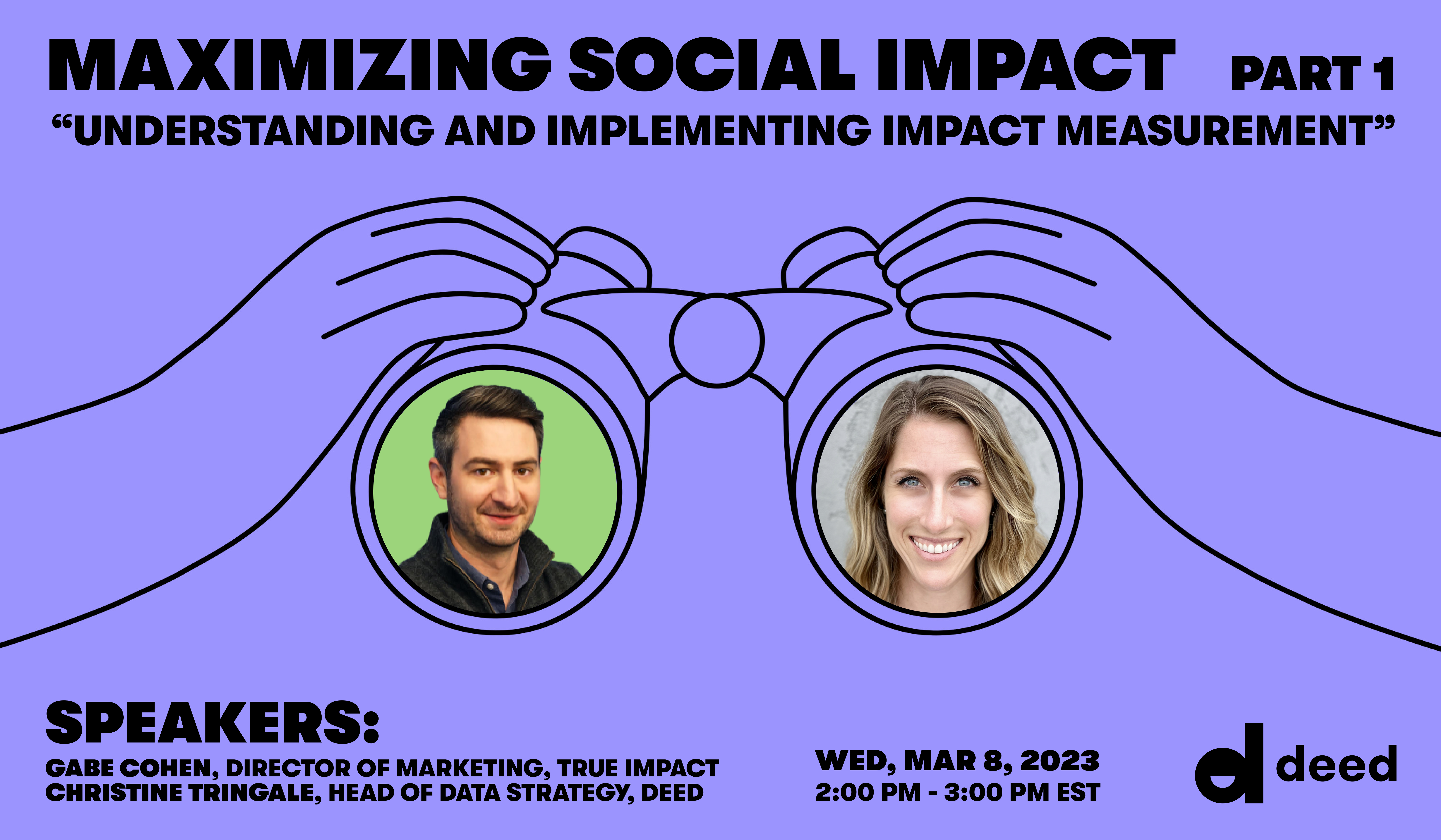5 Takeaways from “Maximizing Social Impact”
ICYMI: Deed and True Impact are teaming up for a three-part webinar series on capturing, measuring, and using impact data.
Introduction
Socially and environmentally responsive programs need data to run well. Without it, our employees will feel like their contributions aren’t making a difference—and our communities won’t be able to see the good work our organizations are doing.
On Wednesday, March 8 @2PM EST, Christine Tringale (Head of Data Strategy at Deed) and Gabe Cohen (Director of Marketing at True Impact) launched "Maximizing Social Impact," an ongoing conversation exploring how to use data to make a meaningful social impact.
This first installment in our three-part webinar series, "Understanding and Implementing Impact Measurement," looked closely at employee giving, volunteerism, and answered questions like:
🧮 What is social impact measurement?
🧮 Why does measuring social impact matter?
🧮 How should I use the data I’ve gathered to make better, more meaningful decisions?
🧮 How can we use social impact data to drive real positive change?
As you make your way through these five key takeaways from “Maximizing Social Impact,” don’t forget to grab your recording of the webinar to hear Gabe and Christine’s thoughts and questions from the audience.
5 Takeaways from “Maximizing Social Impact”
1. There’s a huge difference between intent and impact
At the top of the webinar, our panelists asked attendees to see if they could identify what is wrong with this public statement from a major company:
“Equity, diversity, and inclusion are part of [our company’s] core values. Since 2020, we’ve committed more than $10 million to address racial equity and social justice in the United States.”
The problem? As good as this may sound, the message tells us nothing about the tangible impact the company is making. You would be right to ask:
- Has all $10 million already been spent, or was it just pledged?
- If the money’s been spent, which nonprofits were funded?
- What programs were those organizations able to run with the money?
- How did those programs improve the lives of the individuals and communities they serve?
There is a common misperception that the difference between talking about intent and talking about impact is merely rhetorical, a matter of word choice.
The truth is that impact is measurable and knowable; there’s no magic word that can take the place of the number of mouths fed, backs clothed, or pounds of carbon taken out of the supply chain.
2. Not measuring impact leaves companies vulnerable
Imagine, for one moment, that you and your social impact team have just put together what you think is an effective plan for corporate social responsibility (CSR). Maybe you have a real proposal in mind, or maybe you’re envisioning the one that you hope to create someday soon.
Think about how you would respond to these questions:
- When the CEO asks: “Can we trust that our impact data will stand up to public scrutiny?”
- When a skeptical consumer takes to Twitter to ask: “You say that you support DEIB, but how are you actually supporting local Black indigenous people of color (BIPOC) communities?”
- When the foundation president asks: “Which intervention strategies will best deliver on our goals?”
- When the board chair asks: “We’ve spent millions on different charitable initiatives. Where’s the social return on investment (SROI)?”
- When you ask yourself: “Are we really moving the needle on these causes we care so much about?”
It will be challenging (if not impossible) to answer any of these questions if you don’t measure your impact on a consistent basis. You’ll need to have an achievable impact measurement strategy in place to make sure you have the data on hand that will help answer these questions.
3. Finding evidence of impact is crucial
Saying we need better data is easy enough, but how do we know what data should be collected for our specific projects and programs? For example, there are quantitative differences between the impact of a park cleanup and a day spent at the food pantry.
Here is an effective flow for assessing the impact of virtually any program through a people-centered lens:
- Find the reach: How many people received services?
- Find the lessons learned: How many people gained important skills or the motivation to improve their lives?
- Find the actions taken: How many people completed a task or changed a behavior?
- Find the outcome: How many people say their lives have improved because of the success of the program?
The answers to these questions provide hard evidence that back up your claims of making an impact from a given activity.
4. Getting impact measurement right means purpose, credibility, validation, and improvement
Social impact measurement can seem overwhelming, with so many dollars to track and volunteer hours to log into your social impact platform.
Remember to always start with your organization’s core purpose, and to focus on what matters most for your many unique needs and goals.
Measuring your progress will make all the difference when building credibility with internal stakeholders and the public at large. Putting real numbers behind your efforts helps solidify that trust.
Social impact isn’t generated by any one organization operating in a vacuum—it takes a network of people dedicated to make a difference. It’s important to authentically validate the impact you are claiming to have made by giving your partner nonprofits the numbers you are using in your reports so that your stories are aligned and amplify each other.
Finally, while “Maximizing Social Impact: Understanding and Implementing Impact Measurement” focuses on getting the right data, it isn’t just to show the world all the good our organizations are capable of; more importantly, it’s about our programs and communities.
5. Prove, then improve
Now that you have a better grasp on how to measure the success of your social impact program, how can you use that information to take your efforts to the next level?
First, you’ll want to reach out to your nonprofit partners to make sure that the process you currently have in place to keep track of your joint work is setting you both up for success. If you have a plan in place that only captures some of your data, then your efforts may not take you where you want to go.
Second, once you and your nonprofit partners are on the same page, it’s important to take a step back and set clear, coherent, achievable goals for your philanthropic efforts, so that everybody sees where the work is headed.
Third, spread the good word. Send a note to your environmental, social, and governance (ESG), communications, and social media teams to make sure that you’re giving them numbers that they’re excited to share, and that help them achieve their team’s goals as well.
Finally—and nonprofits will thank you for this one most of all—stop asking your partners to report on things that don’t matter. Now that you know which metrics are most relevant to your work, give your partners back that time to focus on what they do best.
Final thoughts
“Maximizing Social Impact: Understanding and Implementing Impact Measurement” is a three-part webinar series from True Impact and Deed. We’re trying to lower the barrier for entry to meaningful impact measurement by breaking it down into achievable steps. Our hosts are Gabe Cohen, Director of Marketing at True Impact, and Christine Tringale, Head of Data Strategy at Deed.
Keep an eye out for our announcement on the next installment in the next few weeks. But if this first installment has already given you ideas about how to better run your social impact program and capture the most important metrics with social impact tech, reach out now to hear how Deed is helping Airbnb, lululemon, and the world’s CSR leaders get it done.
About True Impact
True Impact is a social impact measurement platform that helps social change leaders like you at purpose-driven enterprises translate their cash, volunteerism, and in-kind donations into real, measurable change. Over 16 years of working with more than 140 companies and thousands of their nonprofit partners, we’ve developed an emphatic approach to CSR impact measurement. We’ve worked with PepsiCo, Dow, Deloitte, GSK, Timberland, and dozens of other companies to use practical measurement processes to drive more—and more successful—social investment. Together, we determine what works and find ways to do things better.
About Deed
Deed is a workplace giving and volunteering platform that puts people first, because user experience shouldn’t stand between you and doing good. We help social impact and DEIB teams foster genuine human connection by empowering employees to support causes they care about together in-person and online, with the data and insights they need to drive engagement. Backed by PayPal and a solid infrastructure of trusted payment processors, our Fortune 500 partners support +2 million nonprofits with ease. And together, our community is doing more good deeds everyday at work, at home, in our neighborhoods, and all over the world.



